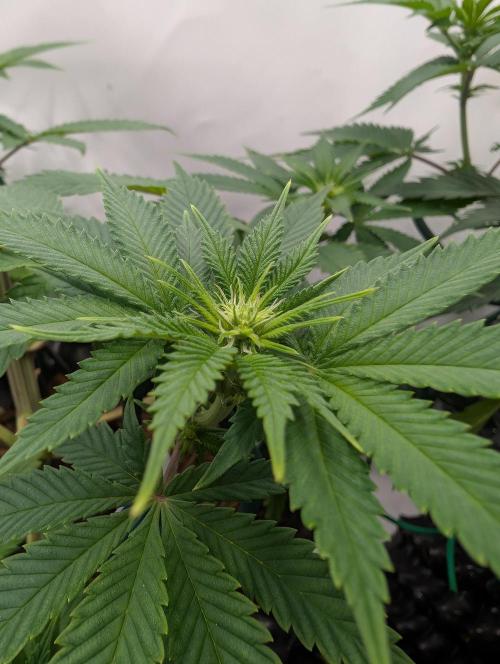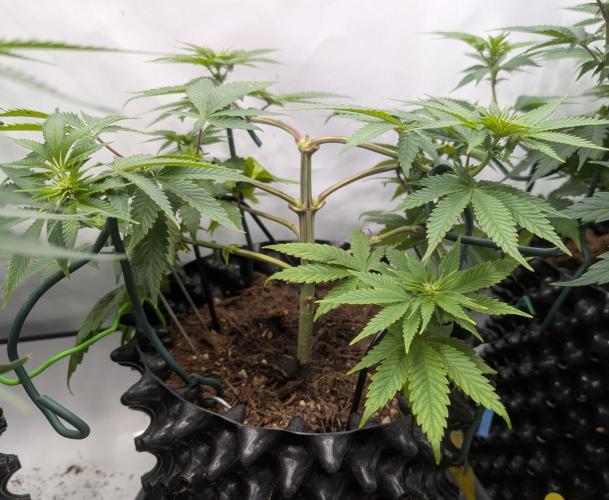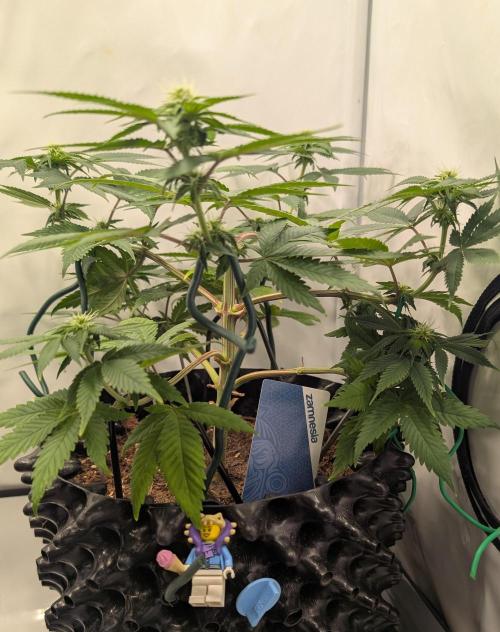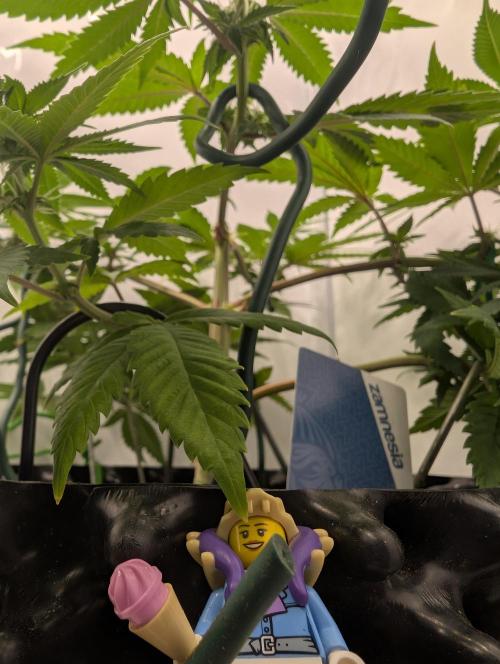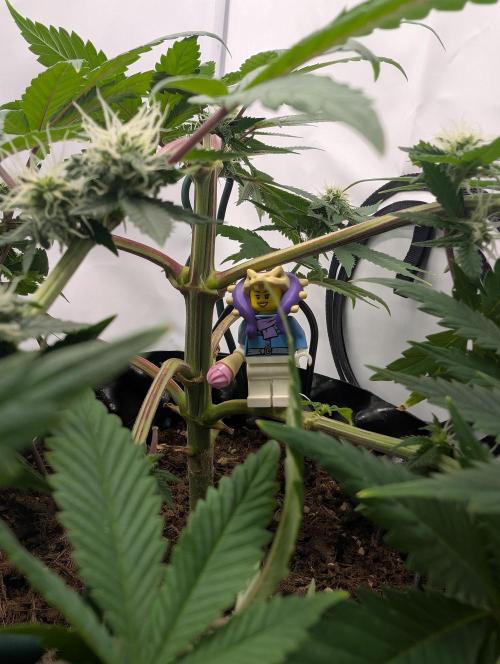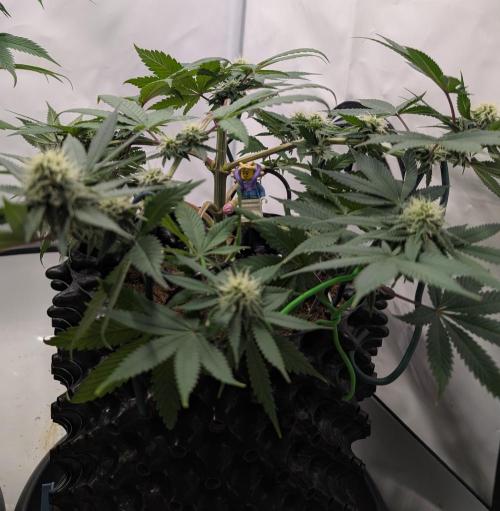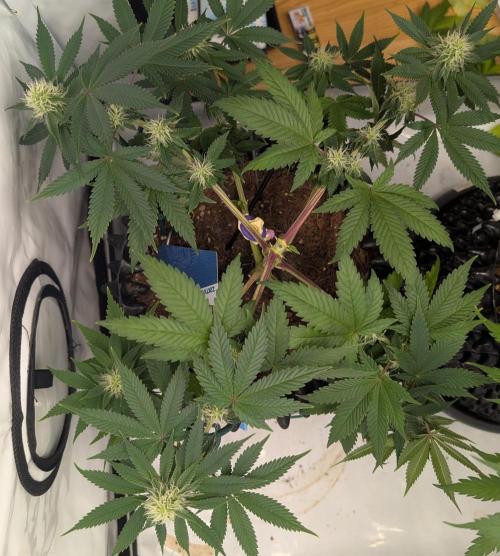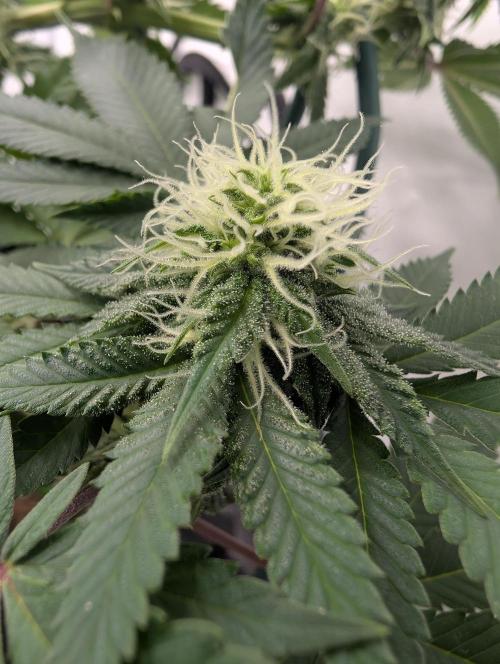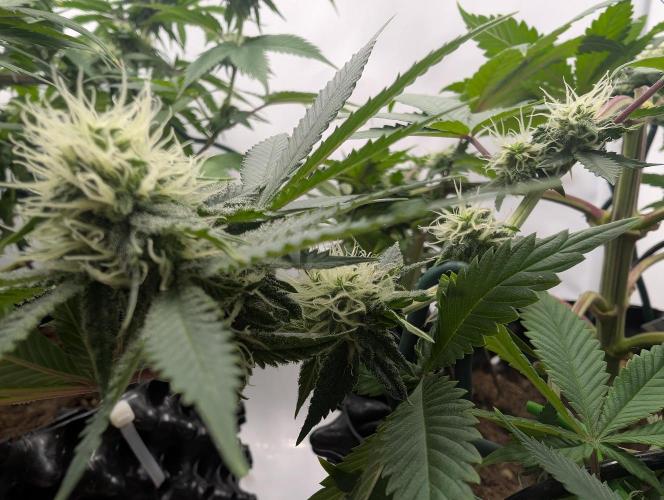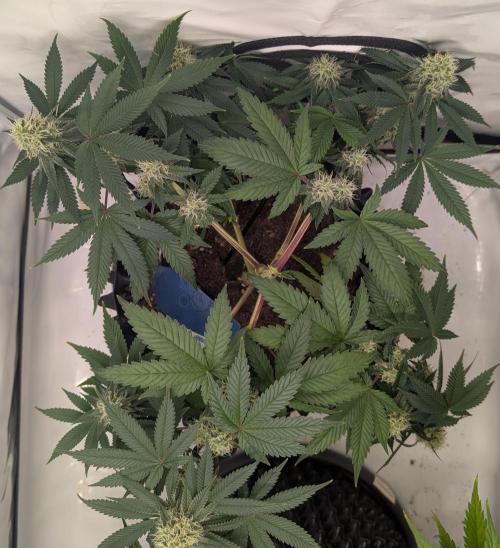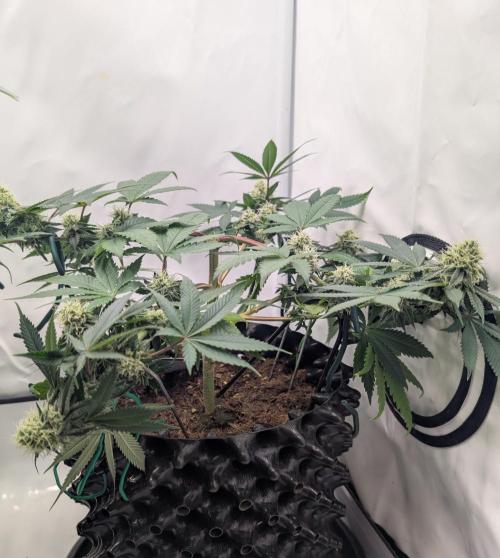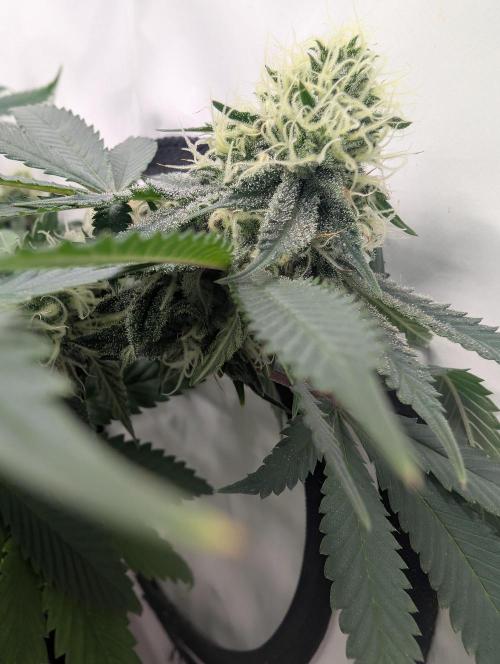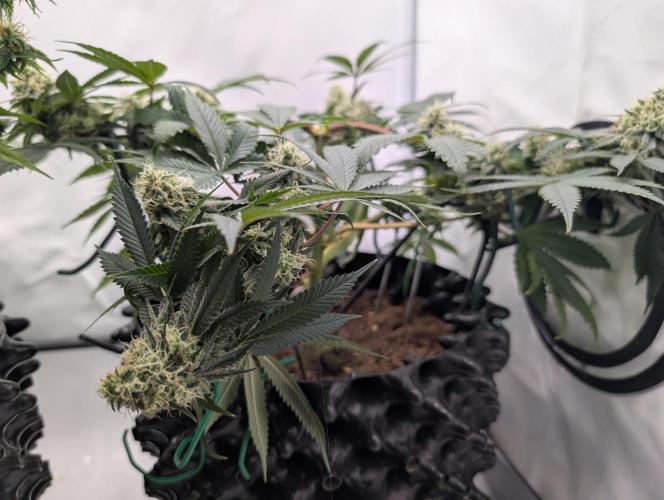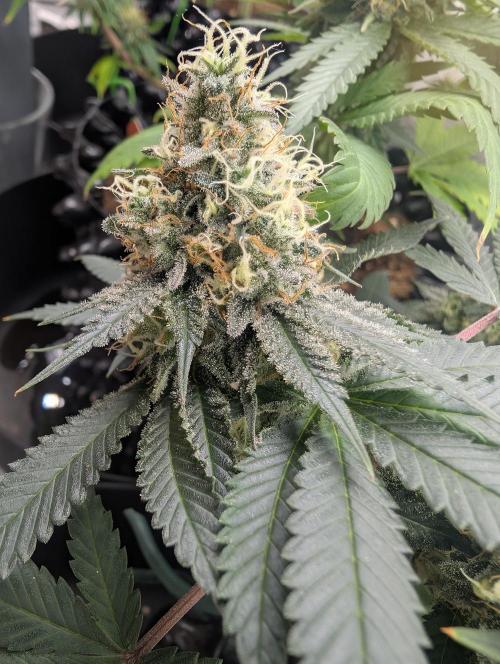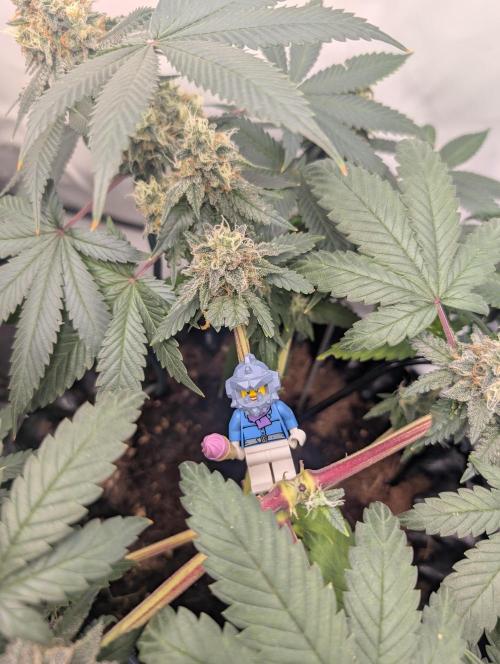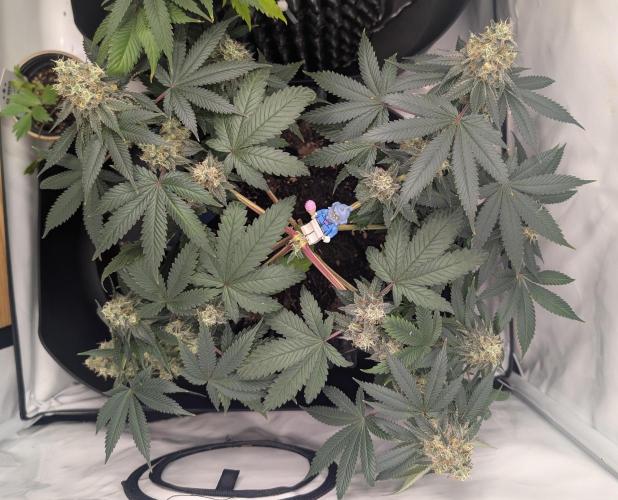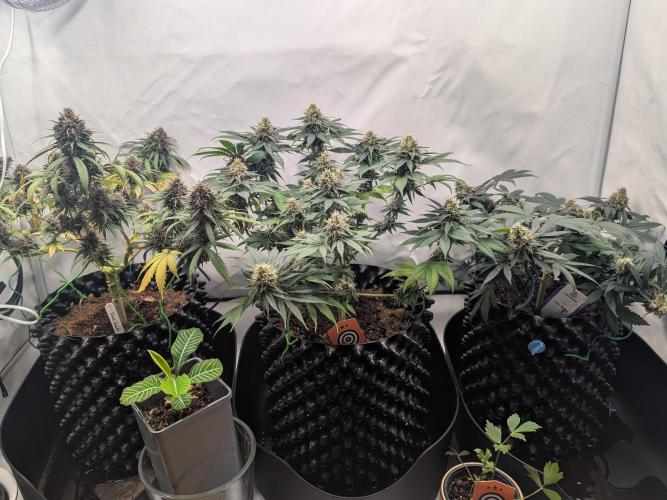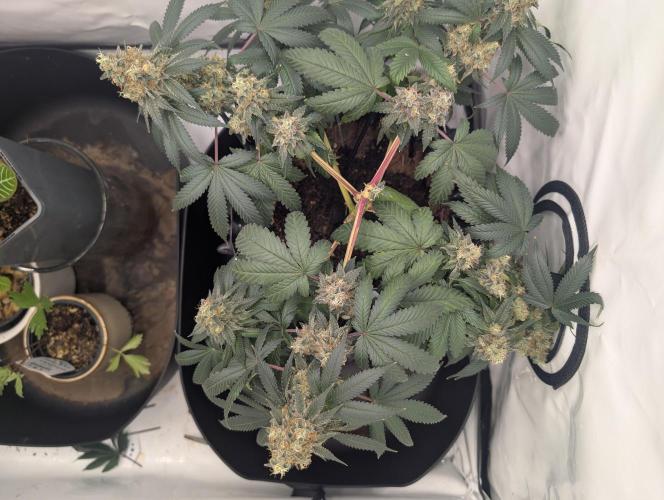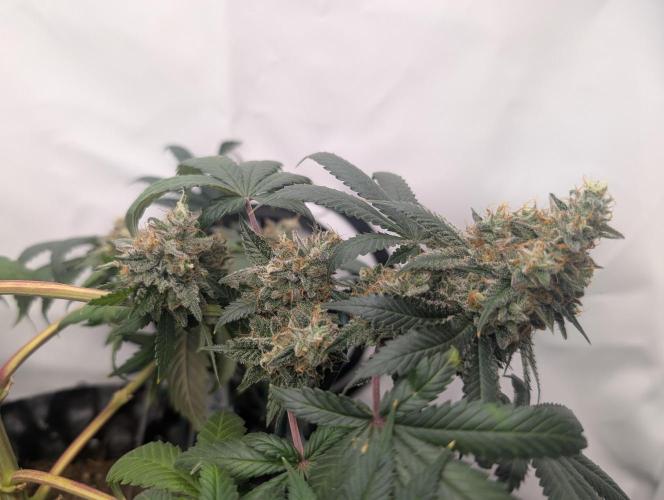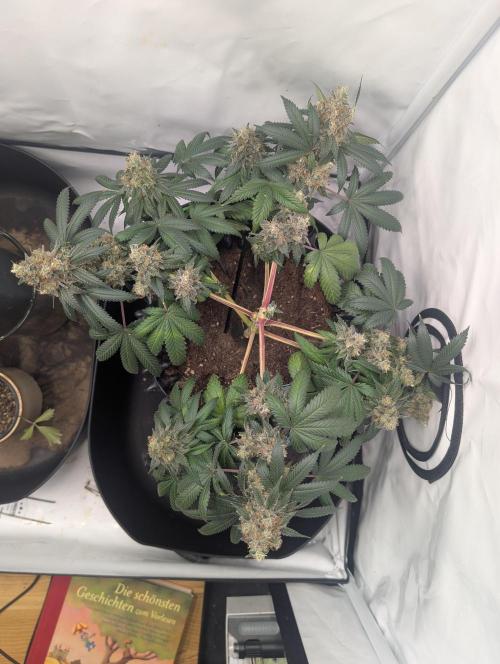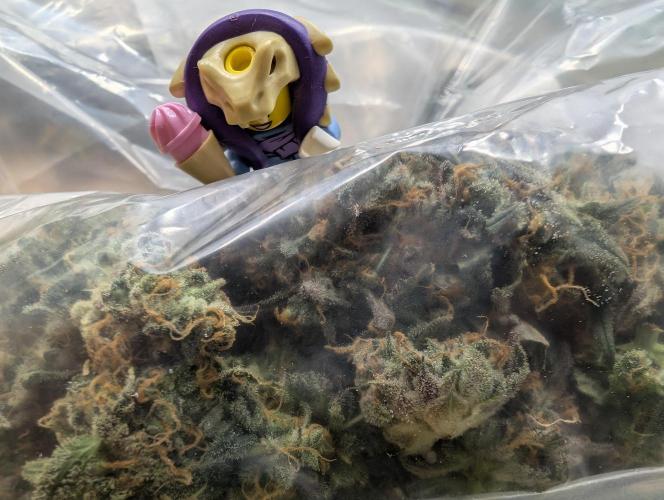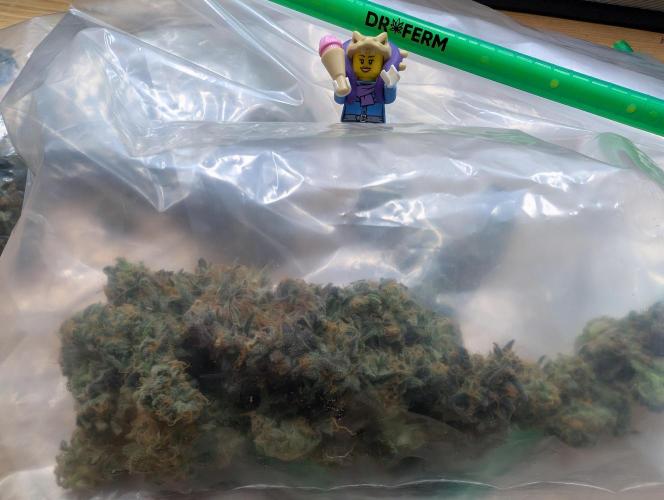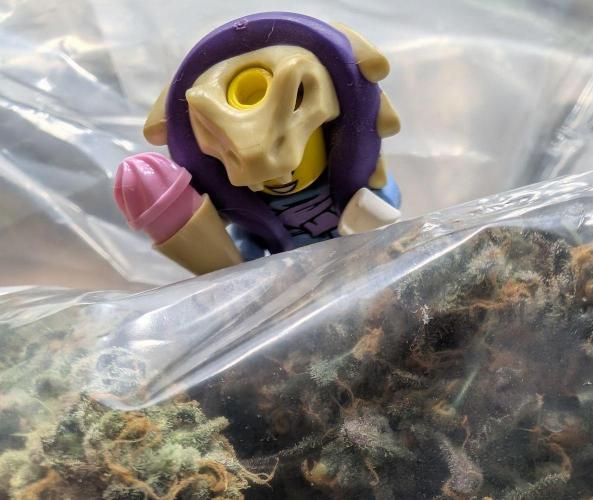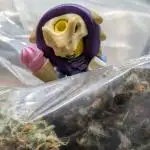The Grow Awards 2026 🏆 














































Zamnesia Pink Rozay
Soil
Obi Grow Light
Perlite
Pumice
Indoor
Room Type
12-12
weeks 1, 7
Topping
weeks 5
Defoliation
weeks 6, 9-10, 15
12 liters
Pot Size
0.7 liters
Watering
Start at Harvest
G
Germination7mo ago
Nutrients 3

PH- Powder
1 mll

Living Organics
5 mll

Humic Acid Plus
1 mll
kohlrabi I've heard good things about this strain - Zamnesia Pink Rozay - and I'm curious to see whether my plant will also take on a slightly pink colour. The strain is indica-dominant and is said to have a fruity flavour.
With this grow circle, I want to use up the liquid fertiliser stocks I still have - ideally use all of them up before the start of summer. So this time I'm fertilising with the Greenbuzz line again. Luckily, all three seeds I planted germinated at exactly the same time - so I only have to make the same mixture once a day for all three plants.
For me, it works best to soak the seeds for 24 hours in distilled water with a few drops of humic acid and then germinate directly into a Root Riot Cube in the final pot. I'm not particularly good at repotting tender plants. And with this method, I can almost set the clock for the plants to poke their heads out of the soil after 4 days.
The soil is ‘Grow’ from Obi, the Light Mix. It mainly consists of coconut fibres. I have mixed approx. 20% pumice with it. I sprinkled ‘Living Organics’ around and into the growing cube to start the exchange of microorganisms with the roots.
12 likes
6 comments
Share
Used method
Directly In Substrate
Germination Method
1
Week 1. Vegetation7mo ago
5 cm
Height
18 hrs
Light Schedule
23 °C
Day Air Temp
12 liters
Pot Size
0.33 liters
Watering Volume
60 cm
Lamp Distance
Nutrients 3

More Roots
2 mll

Growzyme
5 mll

Humic Acid Plus
5 mll
kohlrabi Pink rozay – to my horror, there is almost nothing pink in my Lego collection. And certainly not wine. So I improvised, please bear with me...
All my plants saw the light of day (or at least the light of the grow box) on the same day (day 4). So far, everything is going perfectly according to plan!
The seedlings will receive 2ml ‘More Roots’, 5ml Growzyme and 5ml humic acid per litre in the first week, in line with the Greenbuzz cultivation scheme.
Unfortunately, I'm dealing with fungus gnats again. Nematodes are already on their way. I could slowly start my own breeding programme; that would probably be cheaper in the long run.
Speaking of making things cheaper: At least I've now set up a recycling system for soil. I produce organic waste ferment (bokashi), which I store for two weeks with the used soil from the last grow circle and then later add earthworms. In theory, it should be usable soil again after three months. I'm excited to see how it turns out.
Let's see which of my three varieties stretches the most – that one will be used for mainlining. Hopefully without too much stress for the plant this time.
16 likes
13 comments
Share
Used techniques
12-12
Technique
2
Week 2. Vegetation7mo ago
6 cm
Height
18 hrs
Light Schedule
23 °C
Day Air Temp
No Smell
Smell
12 liters
Pot Size
0.33 liters
Watering Volume
60 cm
Lamp Distance
Nutrients 6

More Roots
3 mll

Growzyme
2 mll

Humic Acid Plus
2 mll
kohlrabi Three updates in just one week? Indeed. And that was because I had difficulty creating new journals in GD. Ultimately, it was probably due to the (too long?) titles that kept causing a non-specific error message to appear. That's why my three latest diaries have such boring titles.
I'll take the liberty of writing the same text for all three strains, because they're all the same: on day 8, they were exactly 6 cm tall and all of them look healthy.
In the meantime, they have received their dose of nematodes to combat fungus gnats. This problem has not yet been resolved.
The plants will now receive the following Greenbuzz additions per liter:
1 ml Grow
3 ml Roots
5 ml Fast Buds
2 ml Humic Acid
2 ml Growzyme
5 ml CalMag
Since I was asked in a short message how I recycle my old soil and what ‘bokashi’ is, there are also two (somewhat disgusting?) pictures.
In short, this is what I do:
I chop up my organic waste and put it in a bokashi bucket with special microorganisms. Unlike traditional compost, you can also use citrus fruits, cooked food and even meat. (Photo 1 shows the bucket before it is closed.)
The microorganisms ferment the organic waste in the absence of air. After about four weeks, I have approximately 19 litres of fermented material. (Photo 2 shows the material after fermentation.)
Now I mix this material with ordinary soil. Within another two weeks, the waste has (almost) completely turned into soil. It already contains many nutrients – more than ordinary compost. And now I add this mixture to a large container with my lovely little earthworms. The worms must not be added too early, otherwise it will be too acidic for them. And then the soil is soon ready for the next plants.
By the way, this substrate is then so nutrient-rich that you should only fertilise very sparingly. For the delicate plants at the beginning, you need soil that contains fewer nutrients.
See you again next week!
14 likes
2 comments
Share
3
Week 3. Vegetation7mo ago
9 cm
Height
18 hrs
Light Schedule
23 °C
Day Air Temp
No Smell
Smell
12 liters
Pot Size
0.33 liters
Watering Volume
60 cm
Lamp Distance
Nutrients 5

More Roots
4 mll

Growzyme
3 mll

Humic Acid Plus
3 mll
kohlrabi Everything is going well, not much to report. I should clean the bottle.
Even the pest is under control again.
See you next week!
17 likes
6 comments
Share
4
Week 4. Vegetation7mo ago
16 cm
Height
18 hrs
Light Schedule
23 °C
Day Air Temp
No Smell
Smell
12 liters
Pot Size
0.33 liters
Watering Volume
60 cm
Lamp Distance
Nutrients 5

More Roots
4 mll

Growzyme
3 mll

Humic Acid Plus
3 mll
kohlrabi Of the three plants, Pink Rozay is the smallest, but it too has five pairs of leaves. To be fair, it's worth mentioning that her pot is also the smallest – although I don't know if that's decisive at this early stage.
It's fun to compare the growth of the three plants, as they sprouted on exactly the same day and have very similar conditions. Tomorrow I will top this plant and then there will only be a little LST left. My free time is limited and I don't want to overdo it with the training.
I may have been too quick to celebrate: the fungus gnats are still not completely gone. Normally, I add nematodes to the water as soon as I spot the first tiny flies. This time, I had to order some first, and the retailer kept me waiting for a whole week and a half. The creatures made good use of those weeks. (A female can lay up to 1,000 eggs!) I'll keep an eye on it and order some more nematodes soon. If that doesn't help, I'll try neem oil. The plants don't seem to be suffering too much, but it's not nice to see flies buzzing around every time I open the grow box.
At least I managed to clean the watering bottles. I hope you appreciate that.
13 likes
10 comments
Share
5
Week 5. Vegetation6mo ago
25 cm
Height
18 hrs
Light Schedule
23 °C
Day Air Temp
No Smell
Smell
12 liters
Pot Size
0.33 liters
Watering Volume
60 cm
Lamp Distance
Nutrients 5

More Roots
4 mll

Growzyme
3 mll

Humic Acid Plus
3 mll
kohlrabi As you can clearly see from above, the leaves of the plant are coloured in a way that is usually caused by a nutrient imbalance. So far, I have been able to control this by adding CalMag, but this time there has been no change. It is also surprising that it is the only plant to react in this way, as the other two plants are being fertilised with exactly the same mixture.
On day 25, she was topped, which is now hardly visible as everything has grown back so well. I am trying to treat the branches with LST, but I don't usually have the time to do it properly.
For the first time in my time as a plant mum, I was unable to control the fungus gnats with nematodes. Either I started too late, or perhaps the worms from this delivery were already dead, because nothing has changed even after the second watering with nematodes. So, on day 26, I sprayed the plants with a mixture of water and neem oil and also watered the soil with it. This spray has worked wonders in repelling aphids in my small garden, and it remains to be seen how it will affect those pesky little flies.
12 likes
comments
Share
Used techniques
Topping
Technique
6
Week 6. Vegetation6mo ago
25 cm
Height
18 hrs
Light Schedule
23 °C
Day Air Temp
No Smell
Smell
12 liters
Pot Size
0.5 liters
Watering Volume
60 cm
Lamp Distance
Nutrients 5

More Roots
4 mll

Growzyme
3 mll

Humic Acid Plus
3 mll
kohlrabi This little plant is still worrying me. I treat it basically the same as my other plants, but something seems to be wrong. My current theory is that I have overwatered it (its pot is smaller than the other pots). I have read that in such cases, you should let the pot dry out and then start watering more sensibly, so I am trying that now. I haven't watered it for two days and started again today with a smaller amount. Keep your fingers crossed that she recovers.
If this plant doesn't make it, it would be a shame, but at least I have two friends who usually benefit from my gardening skills, and I gave them plants for their balconies in the spring. So even if we can only finish two plants by ourselves, there should be a little something left over for us from their grows.
Neem oil was great for the aphids on my garden plants and the fly larvae in my bokashi, but despite watering with it several times, the fungus gnats are completely out of control. I'm now getting 25 million nematodes and hopefully they'll wipe them out. Wish me luck!
Today, on the 36th day of the grow, I'm switching the light to 12/12, and when we meet again next week, hopefully we'll see the first signs of buds. See you soon!
16 likes
comments
Share
Used techniques
Defoliation
Technique
7
Week 7. Vegetation6mo ago
25 cm
Height
12 hrs
Light Schedule
23 °C
Day Air Temp
No Smell
Smell
12 liters
Pot Size
0.7 liters
Watering Volume
60 cm
Lamp Distance
Nutrients 6

More Roots
2 mll

Growzyme
4 mll

Humic Acid Plus
4 mll
kohlrabi Anyone who remembers my 'Pink Rozay' from last week may be surprised at how different the plant looks now. First of all, the problem really seems to have been overwatering. After letting the soil dry out completely and then watering more carefully, it has not developed any further noticeable spots. But it suffered quite a bit before that. I removed some yellow leaves, and what remains is a delicate little plant that is now supposed to start flowering. Poor thing. Let's just see what she does with it.
As is now tradition, every year around the Mary Jane I meet love_2_grow, whom I got to know through this platform. And this year he actually went to a Lego store and recreated me. How funny is that?! So I have a new profile picture. Note the extra-short legs...
The first week of the 12/12 cycle has passed, and I think you can see the beginning of the flowering phase on at least one plant. But since I wouldn't normally switch to ‘flowering week 1’ at the stage I'm seeing here, we're still in the growth phase, week 7, in this diary. Unfortunately, I already switched the nutrients to flowering last week, which probably wasn't a very smart move.
Since I bend it so much, the information about the size of the plant is not very meaningful. It has grown, but you can't tell by its height.
Now that neem oil seems to be working after ages, I'm going to finish off the fungus gnats with nematodes... I hope.
14 likes
1 comment
Share
Used techniques
12-12
Technique
8
Week 8. Flowering6mo ago
28 cm
Height
12 hrs
Light Schedule
23 °C
Day Air Temp
No Smell
Smell
12 liters
Pot Size
0.7 liters
Watering Volume
60 cm
Lamp Distance
Nutrients 5

Growzyme
4 mll

Humic Acid Plus
4 mll

Big Fruits
4 mll
kohlrabi Welcome back! And I'm not just saying that to my readers, but also to this little plant here. It has recovered. After being overwatered and infested with fungus gnats, it has finally regained some of its darker colour and is no longer losing leaves. It probably won't yield much, but I'm grateful that it didn't give up.
I took in a little plant for a friend and promptly had fungus gnats again. So the nematodes are back in action.
I read that fungus gnats don't actually cause much damage themselves, as they tend to feed on dead roots. The reason for their proliferation is overwatering. I obviously still haven't found the right level for watering. I had considered getting some chinchilla sand to cover the surface of the pots – this should prevent the fungus gnats from laying new eggs in the soil. However, I then remembered that I use Airpots, which means that the fungus gnats can also come out through the side holes. I love these Airpots, but that would probably be a reason to switch to felt pots after all. However, I would then have to learn how to water them all over again... Do I need an AutoPot, or will I learn how to do it at some point?
Apart from that, we've had a pleasantly uneventful week.
13 likes
7 comments
Share
9
Week 9. Flowering6mo ago
28 cm
Height
12 hrs
Light Schedule
23 °C
Day Air Temp
Weak
Smell
12 liters
Pot Size
0.7 liters
Watering Volume
60 cm
Lamp Distance
Nutrients 5

Growzyme
4 mll

Humic Acid Plus
4 mll

Big Fruits
4 mll
kohlrabi It's hedgehog season! The plant is developing wonderfully. I have changed my watering habits – many thanks to nonick123 for the tips!
Actually, I could have figured it out myself: don't water according to a schedule, but assess each plant individually. But sometimes you just can't see the forest for the trees. And I am honestly surprised at how differently my three plants consume water.
14 likes
comments
Share
Used techniques
Defoliation
Technique
10
Week 10. Flowering5mo ago
28 cm
Height
12 hrs
Light Schedule
23 °C
Day Air Temp
Weak
Smell
12 liters
Pot Size
0.5 liters
Watering Volume
60 cm
Lamp Distance
Nutrients 5

Growzyme
4 mll

Humic Acid Plus
4 mll

Big Fruits
4 mll
kohlrabi After my negligent treatment a few weeks ago, the Zamnezia plant is lagging behind the other two plants, but I am pleased that there are no further problems. Even the fungus gnats have finally disappeared. I am delighted with the small flowers and am excited to see how far it will go.
My watering has improved, but I must admit I'm considering Autopots. As always, it's a question of money, so it will probably take a few more growing cycles before I'm ready. And who knows, maybe I'll have mastered watering by then?
Otherwise, there is little to report. All my plants have started flowering vigorously and I'm curious to see how long it takes before the first one is ready to be harvested.
13 likes
3 comments
Share
Used techniques
Defoliation
Technique
11
Week 11. Flowering5mo ago
28 cm
Height
12 hrs
Light Schedule
23 °C
Day Air Temp
Weak
Smell
12 liters
Pot Size
0.5 liters
Watering Volume
60 cm
Lamp Distance
Nutrients 5

Growzyme
4 mll

Humic Acid Plus
4 mll

Big Fruits
4 mll
kohlrabi This small plant has managed without stretching and has not developed any significant side branches. However, the flowers on the existing branches are quite impressive.
12 likes
comments
Share
12
Week 12. Flowering5mo ago
28 cm
Height
12 hrs
Light Schedule
23 °C
Day Air Temp
Normal
Smell
12 liters
Pot Size
0.7 liters
Watering Volume
60 cm
Lamp Distance
Nutrients 5

Growzyme
4 mll

Humic Acid Plus
4 mll

Big Fruits
4 mll
kohlrabi The plants are growing excellently and there isn't much to report, so today I'm writing about a slightly different topic:
I was a little sad that I couldn't afford Autopots at the moment, but Mrs Larimar cheered me up by pointing out that the principle is similar to watering from below. I also like the root formation in my Airpots – and since you can position their bottom anywhere you like, they are actually ideal for watering from below. I've done this before with moderate enthusiasm, but never really consistently watered from below.
Now I've seen a video that I'd like to imitate in parts:
https://www.youtube.com/watch?v=wL5yLMzd7JQ
If you have time, please let me know what you think. In any case, I would fertilise with Biotabs and not with minerals. I also need to find a suitable container for the water reservoir. But otherwise, I'm excited to see how it works out. So far, I've only used fabric strips for watering, but I think I'll invest in proper watering wicks.
16 likes
comments
Share
13
Week 13. Flowering5mo ago
28 cm
Height
12 hrs
Light Schedule
23 °C
Day Air Temp
Normal
Smell
12 liters
Pot Size
0.7 liters
Watering Volume
60 cm
Lamp Distance
Nutrients 5

Growzyme
4 mll

Humic Acid Plus
4 mll

Big Fruits
4 mll
kohlrabi ‘Pink Rozay’ will certainly take the longest, and its flowers are still a bit puny. As I said before, this has to do with watering mistakes. I expect another 3 weeks until harvest, which will probably be the longest I've ever waited for harvest. I'm always amazed at Growmies who sometimes spend 30 or more weeks caring for a plant.
In preparation for my upcoming irrigation system (please bear with me until the next grow, I have to do it too), each plant has been given its own litter tray. Yes, literally: Ikea sold out cat litter trays for just under €4 that are perfect for my pots and future irrigation plans. It was a bargain! This made me very happy.
11 likes
comments
Share
14
Week 14. Flowering4mo ago
28 cm
Height
12 hrs
Light Schedule
23 °C
Day Air Temp
Normal
Smell
12 liters
Pot Size
0.7 liters
Watering Volume
60 cm
Lamp Distance
kohlrabi Super short update: nothing happened, I'm reducing the feeding now and will probably mostly add water this last week.
13 likes
comments
Share
15
Week 15. Flowering4mo ago
28 cm
Height
12 hrs
Light Schedule
23 °C
Day Air Temp
Normal
Smell
12 liters
Pot Size
0.7 liters
Watering Volume
60 cm
Lamp Distance
kohlrabi I'm already realizing that photosynthetic plants aren't for me. We're almost at day 100 and I check the trichomes every day, hoping that my grow box will finally be empty—but they're almost all still clear or cloudy, with no amber color in sight. So I'll just continue with the plan.
I removed a lot of wilted leaves, which this time weren't dried out, but simply already in the autumn stage. Otherwise, I'm forced to remain patient.
13 likes
1 comment
Share
Used techniques
Defoliation
Technique
16
Week 16. Harvest4mo ago
Happy Harvest Day!

8/10
Rated
It was really high time. Today, after taking a look through the microscope, I decided to call it quits. 102 days! The next grow will be with automatics again.
The harvest isn't particularly large (119g wet), but it should be mentioned again that the stunted growth of this plant is entirely due to my overwatering at the beginning of the grow. So I wouldn't draw any conclusions about the general potential of this strain from this diary.
Show more
Translate
Spent 107 days
Ger Veg Flo Har
119 g
Bud wet weight per plant
1
Plants
0.5 m²
Grow Room size
Normal
Difficulty
Height
Day air temperature
Light schedule
Pot size
Lamp distance
kohlrabi I used Dryferm bags for the first time for “Apples & Bananas” and am very happy with the result. The drying process is more even than in the air or in the grow box, and there is no smell. Unfortunately, when I bought them, I didn't realize how little you can put in such a huge bag. I wanted to buy more, but the prices are a bit insane. (I bought mine reduced at the Mary Jane.) Fortunately, the drying process for A&B is nearly finished, that's why you can see my new harvest in the bags.
I was grateful that this plant didn't die on me! And now I'm looking forward to try it. See you again in two weeks with the smoke review - and hopefully even earlier with three brand new diaries. :) Cheers!
10 likes
6 comments
Share
Equipment Reviews

the end.
Enjoying this diary? Follow for more updates!
Prefer the old Diary view?
Go back to the old Diary view




























